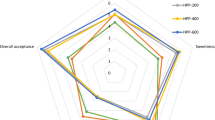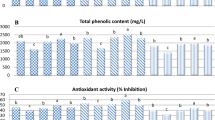Abstract
In the food industry, browning and colour alteration are usually the main problems to solve in red juices. In an attempt to ease complications due to pomegranate juice processing, the combination of thermal treatment, storage at selected temperature and blending of juices was assessed as a novel and combined solution. A pure monovarietal juice, a combination of two widely distinct varietal juices (75 % Mollar de Elche + 25 % Wonderful) and a blend of pomegranate juice plus lemon (75 % + 25 %, respectively) were compared after pasteurization at two different heat treatments (high temperature–short time (HTST) and low temperature–long time (LTLT)). The effect of processing on the bioactive composition and colour parameters was monitored during juice shelf-life at two storage conditions (room and refrigeration temperatures). The reaction kinetics of main phytochemicals and a factorial analysis were also performed in order to achieve comprehensive data on the evolution of juice quality during storage. Results displayed how blending can protect the desirable properties of pomegranate juices better than pure monovarietal juices. Likewise, a high specificity between thermal treatment and kind of juice was found for each considered parameter. HTST exhibited a higher protective role than LTLT for blends of varietal pomegranate juices, whilst LTLT seemed to protect mixtures with lemon much better than HTST. Moreover, the concomitant degradation of anthocyanins and vitamin C and their role in colour variations were exposed. Overall, the array of outcomes might provide a satisfactory solution of colour alteration in pomegranate juices as well as red fruits in general.






Similar content being viewed by others
References
Alighourchi, H., & Barzegar, M. (2009). Some physicochemical characteristics and degradation kinetic of anthocyanin of reconstituted pomegranate juice during storage. Journal of Food Engineering, 90(2), 179–185.
Alighourchi, H., Barzegar, M., & Abbasi, S. (2008). Anthocyanins characterization of 15 Iranian pomegranate (Punica granatum L.) varieties and their variation after cold storage and pasteurization. European Food Research and Technology, 227(3), 881–887.
Alper, N., Bahçeci, K.-S., & Acar, J. (2005). Influence of processing and pasteurization on color values and total phenolic compounds of pomegranate juice. Journal of Food Processing and Preservation, 29(5–6), 357–368.
Borges, G., Mullen, W., & Crozier, A. (2010). Comparison of the polyphenolic composition and antioxidant activity of European commercial fruit juices. Food & Function, 1(1), 73–83.
Brownmiller, C., Howard, L.-R., & Prior, R. L. (2008). Processing and storage effects on monomeric anthocyanins, percent polymeric color, and antioxidant capacity of processed blueberry products. Journal of Food Science, 73(5), H72–H79.
Ferrari, G., Maresca, P., & Ciccarone, R. (2010). The application of high hydrostatic pressure for the stabilization of functional foods: Pomegranate juice. Journal of Food Engineering, 100(2), 245–253.
Fischer, U.-A., Carle, R., & Kammerer, D.-R. (2011). Identification and quantification of phenolic compounds from pomegranate (Punica granatum L.) peel, mesocarp, aril and differently produced juices by HPLC-DAD-ESI/MSn. Food Chemistry, 127(2), 807–821.
Fischer, U.-A., Dettmann, J.-S., Carle, R., & Kammerer, D.-R. (2011). Impact of processing and storage on the phenolic profiles and contents of pomegranate (Punica granatum L.) juices. European Food Research and Technology, 233(5), 797–816.
García-Viguera, C., & Bridle, P. (1999). Influence of structure on colour stability of anthocyanins and flavylium salts with ascorbic acid. Food Chemistry, 64(1), 21–26.
Garzón, G.-A., & Wrolstad, R.-E. (2002). Comparison of the stability of pelargonidin-based Anthocyanins in strawberry juice and concentrate. Journal of Food Science, 67(4), 1288–1299.
Gil, M.-I., Tomás-Barberán, F.-A., Hess-Pierce, B., Holcroft, D.-M., & Kader, A.-A. (2000). Antioxidant activity of pomegranate juice and its relationship with phenolic composition and processing. Journal of Agricultural and Food Chemistry, 48(10), 4581–4589.
González-Molina, E., Moreno, D.-A., & García-Viguera, C. (2008). Genotype and harvest time influence the phytochemical quality of fino lemon juice (Citrus limon (L.) Burm. F.) for industrial use. Journal of Agricultural and Food Chemistry, 56(5), 1669–1675.
González-Molina, E., Moreno, D.-A., & García-Viguera, C. (2009). A new drink rich in healthy bioactives combining lemon and pomegranate juices. Food Chemistry, 115(4), 1364–1372.
Hager, A., Howard, L.-R., Prior, R.-L., & Brownmiller, C. (2008). Processing and storage effects on monomeric anthocyanins, percent polymeric color, and antioxidant capacity of processed black raspberry products. Journal of Food Science, 73(6), H134–H140.
Hager, T.-J., Howard, L.-R., & Prior, R.-L. (2010). Processing and storage effects on the ellagitannin composition of processed blackberry products. Journal of Agricultural and Food Chemistry, 58(22), 11749–11754.
Kirca, A., Özkan, M., & Cemeroğlu, B. (2007). Storage stability of strawberry jam color enhanced with black carrot juice concentrate. Journal of Food Processing and Preservation, 31(5), 531–545.
Martí, N., Pérez-Vicente, A., & García-Viguera, C. (2002). Influence of storage temperature and ascorbic acid addition on pomegranate juice. Journal of the Science of Food and Agriculture, 82(2), 217–221.
Martí, N., Mena, P., Canovas, J.-A., Micol, V., & Saura, D. (2009). Vitamin C and the Role of Citrus Juices as Functional Food. Natural Product Communications, 4(5), 677–700.
Maskan, M. (2006). Production of pomegranate (Punica granatum L.) juice concentrate by various heating methods: Colour degradation and kinetics. Journal of Food Engineering, 72(3), 218–224.
Medina-Remón, A., Barrionuevo-González, A., Zamora-Ros, R., Andres-Lacueva, C., Estruch, R., Martínez-González, M.-A., et al. (2009). Rapid Folin–Ciocalteu method using microtiter 96-well plate cartridges for solid phase extraction to assess urinary total phenolic compounds, as a biomarker of total polyphenols intake. Analytica Chimica Acta, 634(1), 54–60.
Mena, P., Gironés-Vilaplana, A., Moreno, D.-A., García-Viguera, C. (2011a). Pomegranate fruit for health promotion: myths and realities. In Jiménez & García-Viguera (Ed.) Antioxidant Properties of crops III. Functional Plant Science and Biotechnology 5 (Special Issue 2), 33–42.
Mena, P., García-Viguera, C., Navarro-Rico, J., Moreno, D.-A., Bartual, J., Saura, D., et al. (2011b). Phytochemical characterisation for industrial use of pomegranate (Punica granatum L.) cultivars grown in Spain. Journal of the Science of Food and Agriculture, 91(10), 1893–1906.
Mena, P., Gironés-Vilaplana, A., Martí, N., & García-Viguera, C. (2012). Pomegranate varietal wines: phytochemical composition and quality parameters. Food Chemistry, 133(1), 108–115.
Mikkelsen, B.-B., & Poll, L. (2002). Decomposition and transformation of aroma compounds and anthocyanins during black currant (Ribes nigrum L.) juice processing. Journal of Food Science, 67(9), 3447–3455.
Pérez-Vicente, A., Serrano, P., Abellán, P., & García-Viguera, C. (2004). Influence of packaging material on pomegranate juice colour and bioactive compounds, during storage. Journal of the Science of Food and Agriculture, 84(7), 639–644.
Silva, F.-V.-M., & Gibbs, P.-A. (2010). Non-proteolytic Clostridium botulinum spores in low-acid cold-distributed foods and design of pasteurization processes. Trends in Food Science and Technology, 21(2), 95–105.
Syamaladevi, R.-M., Andrews, P.-K., Davies, N.-M., Walters, T., & Sablani, S.-S. (2012). Storage effects on anthocyanins, phenolics and antioxidant activity of thermally processed conventional and organic blueberries. Journal of the Science of Food and Agriculture, 92(4), 916–924.
Turfan, O., Türkyilmaz, M., Yemi, O., & Özkan, M. (2011). Anthocyanin and colour changes during processing of pomegranate (Punica granatum L.; cv. Hicaznar) juice from sacs and whole fruit. Food Chemistry, 129(4), 1644–1651.
Vallverdú-Queralt, A., Medina-Remón, A., Casals-Ribes, I., Andrés-Lacueva, C., Waterhouse, A.-L., & Lamuela-Raventós, R.-M. (2012). Effect of tomato industrial processing on phenolic profile and hydrophilic antioxidant capacity. LWT- Food Science and Technology, 47(1), 154–160.
Verbeyst, L., Bogaerts, R., Van der Plancken, I., Hendrickx, M., Van Loey, A. (2012) Modelling of vitamin C degradation during thermal and high-pressure treatments of red fruit. Food and Bioprocess Technology (in press).
Waskar, D.-P. (2011). Studies on improvement in color of pomegranate juice by blending with kokum juice. Acta Horticulturae, 890, 461–464.
Yildiz, H., Bozkurt, H., & Icier, F. (2009). Ohmic and conventional heating of pomegranate juice: effects on rheology, color, and total phenolics. Food Science and Technology International, 15(5), 503–512.
Zafrilla, P., Ferreres, F., & Tomás-Barberán, F.-A. (2001). Effect of processing and storage on the antioxidant ellagic acid derivatives and flavonoids of red raspberry (Rubus idaeus) jams. Journal of Agricultural and Food Chemistry, 49(8), 3651–3655.
Acknowledgments
The authors wish to thank Salud Vegara for the valuable help in microbiological determinations.
Funding sources
The authors wish to thank Fundación Agroalimed for the financial support of this work (Project “Producción de Zumo de Caqui e Industrialización de Granada”). Pedro Mena was funded by a grant of the FPU Fellowship Programme from the Spanish Ministry of Education.
Author information
Authors and Affiliations
Corresponding author
Rights and permissions
About this article
Cite this article
Mena, P., Martí, N., Saura, D. et al. Combinatory Effect of Thermal Treatment and Blending on the Quality of Pomegranate Juices. Food Bioprocess Technol 6, 3186–3199 (2013). https://doi.org/10.1007/s11947-012-0961-z
Received:
Accepted:
Published:
Issue Date:
DOI: https://doi.org/10.1007/s11947-012-0961-z




